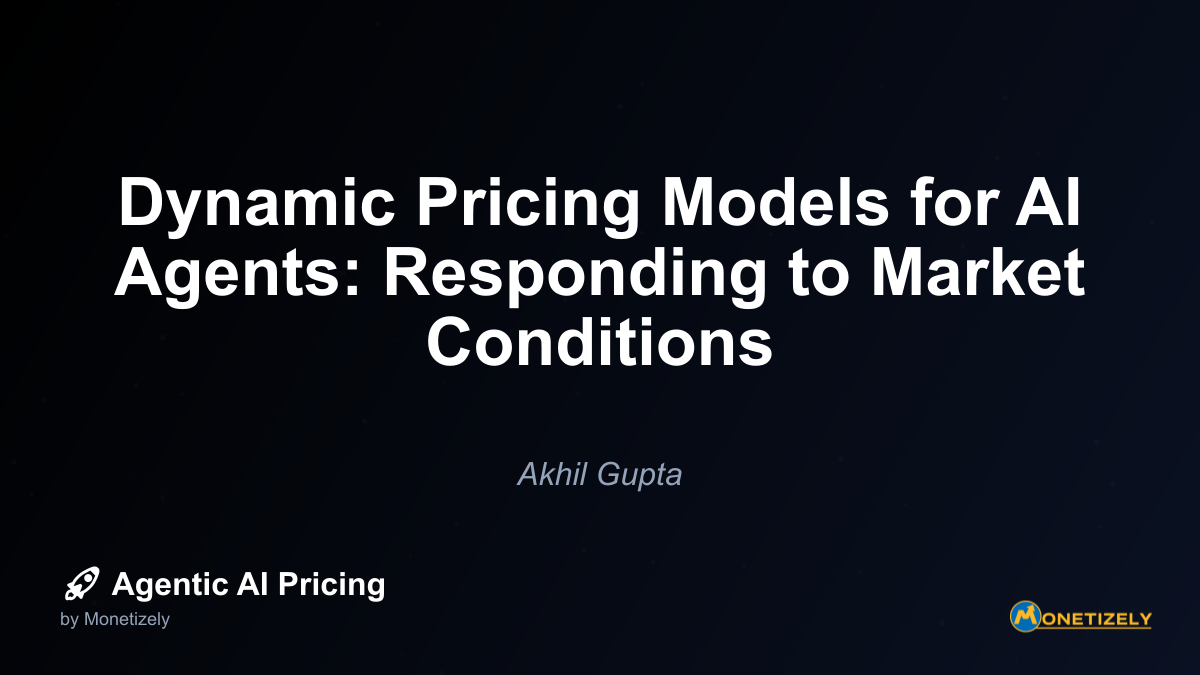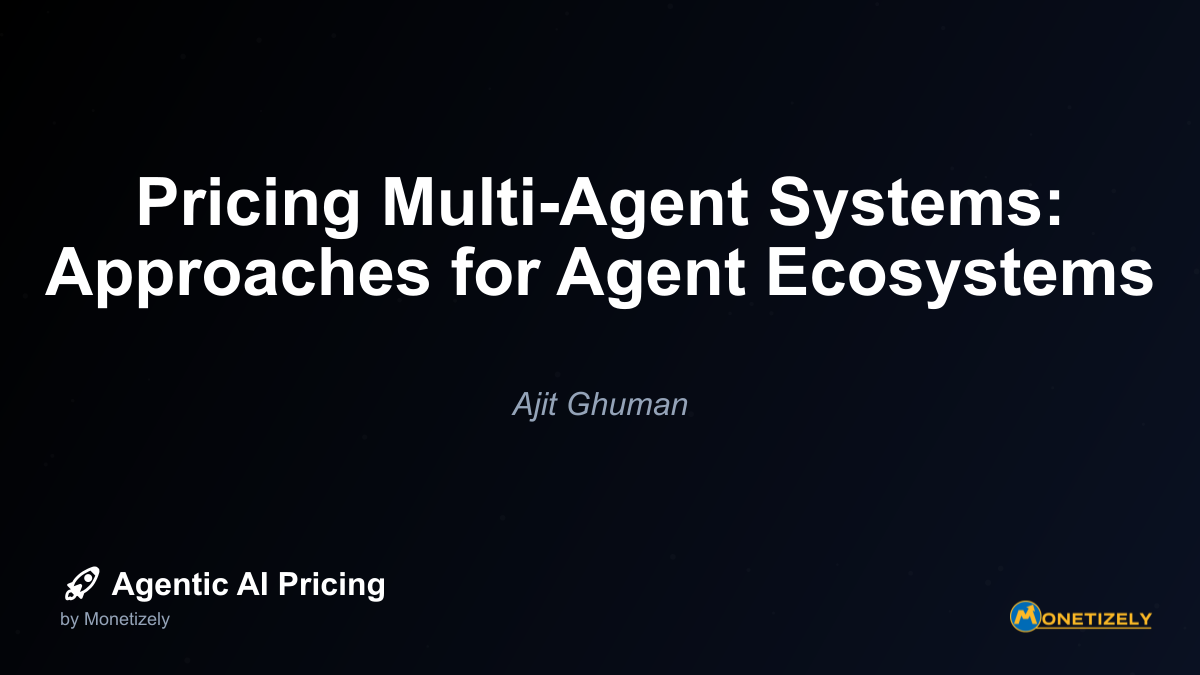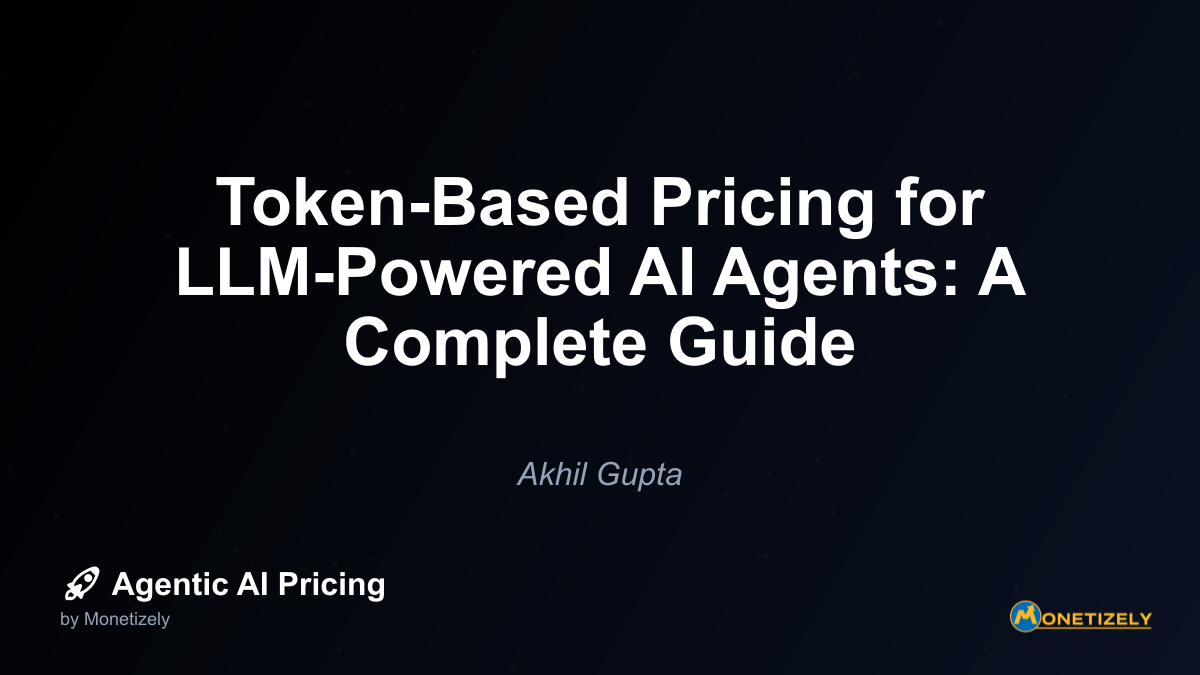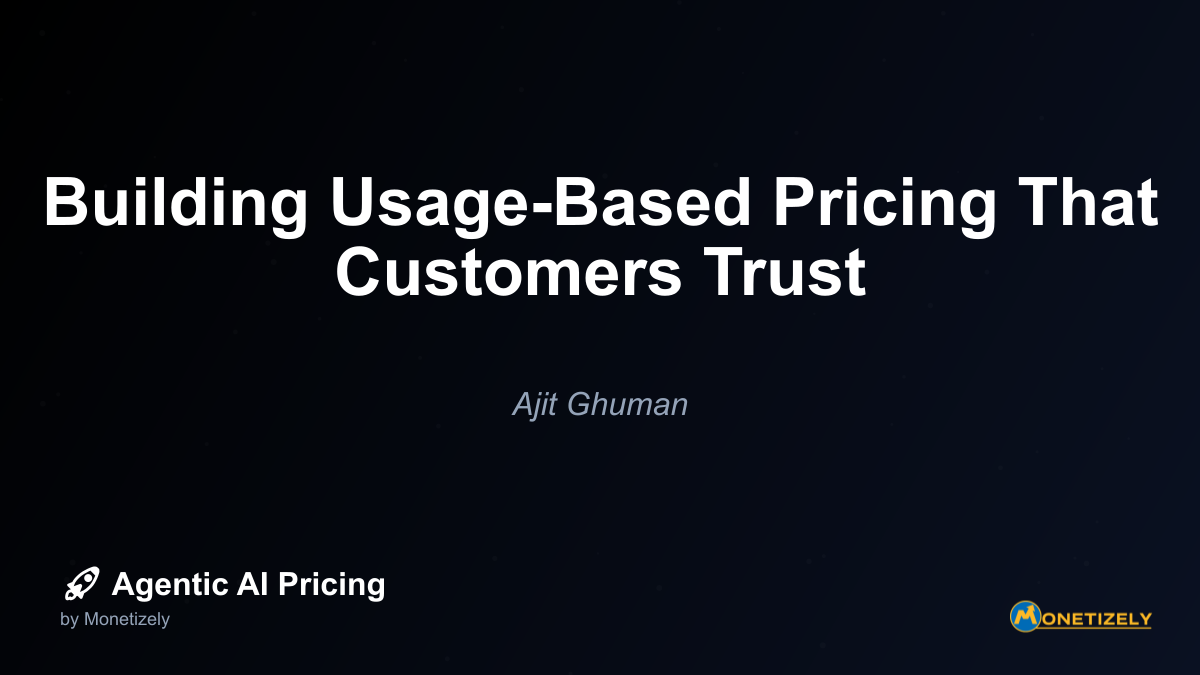· Akhil Gupta · AI Pricing Models · 13 min read
Pricing AI Agent Add-Ons and Extensions: The Marketplace Approach
AI and SaaS Pricing Masterclass
Learn the art of strategic pricing directly from industry experts. Our comprehensive course provides frameworks and methodologies for optimizing your pricing strategy in the evolving AI landscape. Earn a professional certification that can be imported directly to your LinkedIn profile.

In today’s rapidly evolving AI landscape, businesses are increasingly looking beyond standalone AI agents to create more comprehensive and adaptable solutions. One of the most promising approaches is the development of extensible AI agent platforms with add-on capabilities, creating new revenue streams through marketplace models. This strategy not only enhances functionality but also creates sustainable monetization opportunities for both platform providers and third-party developers.
The Rise of AI Agent Marketplaces
AI agent marketplaces represent a significant evolution in how businesses deploy and monetize artificial intelligence. Similar to app stores in the mobile ecosystem, these marketplaces provide a centralized hub where users can discover, purchase, and integrate specialized AI capabilities into their existing systems.
According to recent market analysis, the global AI agents market is projected to grow at a compound annual growth rate (CAGR) between 32% and 46% over the next decade, expanding from approximately $5.26 billion in 2024 to a staggering $236 billion by 2034. This explosive growth is driven by the evolution of AI agents from simple reactive tools into autonomous decision-makers capable of planning, reasoning, and executing complex tasks independently.
The shift toward multi-agent collaboration, where different AI agents communicate and coordinate for complex workflows, has accelerated the need for extensible platforms. These platforms now support thousands of community-created add-ons, fostering a rich ecosystem that enhances the capabilities of base AI models.
Understanding the Marketplace Approach to AI Agent Extensions
The marketplace approach to AI agent extensions follows a platform model where a core AI system provides basic functionality, while specialized capabilities are available as add-ons or extensions. This model offers several advantages:
- Specialization: Third-party developers can create niche solutions for specific industries or use cases
- Scalability: The platform can grow its capabilities without developing everything in-house
- Innovation acceleration: External developers bring diverse perspectives and solutions
- Revenue diversification: Multiple monetization streams beyond the core platform
Types of AI Agent Extensions
AI agent extensions generally fall into several categories:
- Industry-specific extensions: Tailored for verticals like healthcare, finance, or legal
- Functionality extensions: Adding capabilities like data analysis, content generation, or decision support
- Integration extensions: Connecting AI agents with other software systems
- Skill-based extensions: Teaching agents specific skills like language translation or image recognition
- Workflow extensions: Automating complex multi-step processes
The diversity of extension types creates opportunities for varied pricing strategies based on the value delivered and usage patterns.
Revenue Models for AI Agent Marketplaces
AI agent marketplaces employ several revenue models that balance platform sustainability with developer incentives. Understanding these models is crucial for businesses looking to implement marketplace approaches.
Subscription-Based Access
One of the most common models is subscription-based access, where users pay a flat monthly fee for unlimited or tiered access to the marketplace. OpenAI’s GPT Store exemplifies this approach, charging users $20-30 per month for access to custom GPTs created by developers. This model provides predictable revenue for the platform while offering users a simple pricing structure.
The subscription model is particularly effective when:
- Users need regular access to multiple extensions
- Usage patterns are consistent and predictable
- The platform wants to encourage exploration of different extensions
However, subscription models may undervalue specialized, high-impact extensions that deliver significant business value but are used infrequently.
Transaction Fee-Based Revenue Sharing
Many AI marketplaces implement a transaction fee-based revenue sharing model, taking a percentage (typically 10-30%) of the revenue generated by developers. This approach aligns platform and developer incentives, as both parties benefit from successful extensions.
The revenue share percentage often varies based on several factors:
- Extension complexity and uniqueness
- Developer reputation and track record
- Sales volume and user engagement
- Exclusive vs. multi-platform availability
OpenAI has implemented quality-based incentives in its revenue-sharing model, reducing fees for high-rated agents to encourage innovation and higher engagement. This approach has proven successful, with OpenAI paying out over $3.5 million to GPT creators within just three months of operation.
Usage-Based Pricing
Usage-based pricing models charge based on actual consumption, whether measured by API calls, compute resources, or other metrics. Companies like Fixie.ai employ this approach, aligning costs directly with the value received.
Usage-based pricing works well for:
- Extensions with variable utilization patterns
- Enterprise customers with fluctuating needs
- High-value extensions where per-use pricing makes sense
- Platforms serving diverse customer segments with different usage levels
Cognition AI, for example, charges $2.25 per compute unit for agent engineering tasks, abstracting computational complexity into consumable units that customers can easily understand and budget for.
Price Per Agent (FTE Model)
An emerging pricing approach positions AI agents as digital employee replacements, charging a fixed monthly fee per agent. Companies like Harvey, 11x, and Vivun have adopted this model, typically charging around $2,000 per month per agent—positioned as replacing a junior hire worth $60,000 annually.
This model makes pricing intuitive for business decision-makers by tying it to familiar headcount costs rather than technical metrics. It’s particularly effective for:
- Enterprise customers familiar with employee costs
- Agents that perform well-defined roles comparable to human jobs
- Solutions targeting specific departmental budgets rather than IT
Freemium + Tiered Access
The freemium model offers basic functionality for free while charging for premium features or higher usage tiers. This approach lowers adoption barriers while creating upgrade paths for committed users.
Data shows that freemium models typically result in 3-7% conversion rates from free to paid tiers, providing a sustainable revenue flow as marketplaces mature. The key to successful freemium implementation is carefully balancing what’s offered for free versus paid tiers to create clear value differentiation.
Hybrid Revenue Models
In practice, many successful AI marketplaces implement hybrid revenue models combining multiple approaches:
- Free tier + subscription options + usage-based overages
- Platform subscription + extension-specific charges
- Base pricing + outcome-based bonuses
- Tiered access with different revenue share percentages
These hybrid models offer flexibility to accommodate diverse user needs and extension types while maximizing revenue potential.
Case Studies: Successful AI Agent Marketplace Implementations
Examining real-world implementations provides valuable insights into effective marketplace strategies and pricing models.
OpenAI’s GPT Store
OpenAI’s GPT Store represents one of the most visible AI agent marketplaces, allowing developers to create and monetize custom GPTs. The platform uses a subscription-based access model, where users pay a monthly fee for unlimited access to extensions.
Key features of OpenAI’s approach include:
- User subscription pricing ($20-30/month)
- Developer payouts exceeding $3.5 million in the first three months
- Quality-based incentives reducing fees for high-rated agents
- Transparent metrics and analytics for developers
The success of OpenAI’s marketplace demonstrates the potential of subscription models combined with quality incentives to drive both user adoption and developer engagement.
Salesforce Agentforce
Salesforce has taken an innovative approach with its Agentforce AI marketplace, implementing a per-conversation pricing model at $2 per conversation. This represents a shift away from traditional seat licenses, aligning revenue directly with usage and scaling cost with the volume of AI-enabled customer interactions.
This outcome-based pricing model ensures customers pay only for resolved issues, creating a direct link between cost and value received. The approach has proven particularly effective for customer service and sales applications where conversation completion represents a clear value metric.
Harvey, 11x, and Vivun
These companies have pioneered the “Price per Agent” model, where each AI agent represents a fractional digital employee replacement with a fixed monthly fee. Typically charging around $2,000 per month per agent, they position their offerings as alternatives to junior hires costing $60,000 annually.
This pricing approach resonates well with enterprise customers since it links directly to cost savings and makes procurement easier by aligning with headcount budgets rather than IT spending. The model is particularly effective for specialized agents performing well-defined roles with clear human equivalents.
Intercom
Intercom has introduced “Digital Workforce Licensing,” treating AI agents as virtual employees with specific usage rights. This approach bridges traditional SaaS with agent-based pricing, creating a familiar framework for businesses accustomed to per-seat licensing models.
By framing AI agents as team members, Intercom helps customers conceptualize value in terms of workforce augmentation rather than abstract technical capabilities. This positioning has proven effective for customer service applications where agents directly supplement or replace human representatives.
Technical Implementation Considerations
Building a successful AI agent marketplace requires careful attention to technical architecture, security, and scalability. These elements form the foundation for both functionality and monetization.
Technical Architecture Requirements
AI agent marketplaces require robust technical architecture to support extensibility, security, and performance. Key architectural patterns include:
- Layered architectures with clear separation of concerns (data processing, decision-making layers)
- Multi-agent systems enabling collaboration between specialized agents
- Hybrid architectures combining reactive and deliberative mechanisms for adaptability
Essential architecture attributes include scalability, flexibility, performance efficiency, and security, ensuring the platform can evolve while maintaining robustness.
API Design for Extensibility
Effective API design is crucial for creating an extensible marketplace that attracts developers. Key considerations include:
- APIs that enable easy integration of diverse AI models and external tools
- Implementation of API management best practices, including rate limiting, authentication, and error handling
- Protocols for managing context state effectively across agent interactions
- Developer-friendly design with clear versioning and extensibility hooks
The quality of API design directly impacts the marketplace’s ability to attract and retain third-party developers, making it a critical success factor.
Security and Compliance
AI agent marketplaces must address significant security and compliance challenges, including:
- Protection against prompt injections, data exfiltration, and other AI-specific threats
- Compliance with relevant regulations like HIPAA for healthcare data and GDPR for privacy
- Implementation of data anonymization, encryption, consent management, and audit logging
- Continuous monitoring for anomaly detection and forensic analysis
Security concerns are particularly important for enterprise customers, who often require rigorous security measures before adopting AI solutions.
Technical Infrastructure Costs and Scaling
Building and operating an AI agent marketplace involves various infrastructure costs that must be considered in pricing models:
- Cloud computing resources for hosting agents and processing requests
- Storage for models, user data, and transaction records
- Bandwidth for API calls and data transfer
- Development and maintenance of the marketplace platform
- Security infrastructure and compliance measures
Successful platforms typically leverage cloud providers such as AWS, Google Cloud, or Azure for flexible hosting, autoscaling, and managed services. This approach allows for cost optimization through a combination of on-demand compute with reserved instances or spot pricing for predictable workloads.
Pricing Strategies for Different Types of AI Agent Extensions
Different types of AI agent extensions require tailored pricing approaches based on their value proposition, usage patterns, and target market.
Industry-Specific Extensions
Extensions tailored for specific industries like healthcare, finance, or legal typically command premium pricing due to:
- Specialized domain knowledge embedded in the agent
- Compliance with industry-specific regulations
- Integration with industry-standard systems and workflows
- Direct impact on high-value business processes
Pricing for these extensions often follows enterprise software models with annual contracts, volume-based pricing tiers, and customization options. The pricing may also reflect the high value and potential cost savings these specialized agents provide.
Functionality-Based Extensions
Extensions that add specific capabilities to AI agents can be priced based on the functionality they provide:
- Basic extensions (e.g., simple data processing) may use freemium or low-cost subscription models
- Advanced extensions (e.g., complex analysis or decision-making) often justify premium pricing
- Unique or proprietary capabilities can command higher prices due to limited alternatives
Functionality-based extensions typically use tiered pricing based on usage volume or feature sets, allowing customers to select the appropriate level for their needs.
Integration Extensions
Extensions that connect AI agents with other software systems are often priced based on:
- The complexity and value of the integration
- The popularity and importance of the integrated system
- The volume of data transferred or processed
- The frequency of synchronization or interaction
These extensions may use a combination of one-time implementation fees and ongoing subscription costs, reflecting both the initial setup effort and continued maintenance requirements.
Skill-Based Extensions
Extensions that teach agents specific skills like language translation or image recognition typically use:
- Usage-based pricing for skills utilized on-demand
- Subscription models for regularly used skills
- Bundle pricing for related skill sets
The pricing often scales with the sophistication and uniqueness of the skill, as well as the computing resources required to perform it.
Metrics for Evaluating Marketplace Success
Measuring the success of an AI agent marketplace requires tracking various metrics related to both platform health and monetization effectiveness.
Developer Metrics
- Developer retention: Percentage of developers who continue creating and maintaining extensions
- Developer satisfaction: Survey results or net promoter scores from developers
- New developer acquisition: Growth rate of the developer community
- Revenue per developer: Average earnings for developers on the platform
High developer engagement and satisfaction are crucial for marketplace growth, as they ensure a steady stream of new and improved extensions.
User Metrics
- User adoption: Number of active users and growth rate
- Conversion rates: Percentage of free users converting to paid tiers (typically 3-7% in freemium models)
- Extension utilization: How frequently users access different extensions
- User retention: Continued usage over time
- Customer satisfaction: Ratings, reviews, and net promoter scores
Strong user metrics indicate that the marketplace is delivering value and has sustainable growth potential.
Financial Metrics
- Total revenue: Overall marketplace earnings
- Revenue growth: Month-over-month or year-over-year increases
- Revenue per user: Average spending per customer
- Marketplace commission: Revenue from transaction fees or revenue shares
- Lifetime value (LTV): Total revenue expected from a customer over their relationship with the platform
- Customer acquisition cost (CAC): Cost of acquiring new customers
Healthy financial metrics demonstrate the viability of the marketplace business model and inform pricing optimizations.
Platform Health Metrics
- Extension quality: Ratings, reviews, and performance metrics for extensions
- Platform reliability: Uptime, response times, and error rates
- Security incidents: Number and severity of security breaches or vulnerabilities
- Support volume: Customer service requests and resolution rates
These metrics help ensure the platform remains attractive to both developers and users by maintaining high standards of quality and reliability.
Challenges and Solutions in AI Agent Marketplace Pricing
Creating effective pricing models for AI agent marketplaces involves addressing several common challenges.
Balancing Platform Revenue and Developer Incentives
Challenge: Finding the right revenue share that provides sufficient income for the platform while attracting and retaining developers.
Solutions:
- Implement progressive take rates that decrease as developer revenue increases
- Offer transparent fee structures and revenue projections for developers
- Provide additional value through developer tools, marketing support, and analytics
- Consider quality-based incentives that reward high-performing extensions with lower fees
Successful marketplaces like OpenAI’s GPT Store have found that reasonable revenue shares (10-30%) combined with quality incentives create sustainable ecosystems.
Pricing Complexity for Diverse Extensions
Challenge: Creating pricing frameworks that accommodate extensions with varying complexity, value, and usage patterns.
Solutions:
- Develop multi-dimensional pricing frameworks combining base fees, transaction fees, and value-added service charges
- Allow developers flexibility in choosing pricing models appropriate for their extensions
- Provide pricing templates and guidance based on extension categories
- Offer analytics tools to help developers optimize their pricing strategies
By supporting multiple pricing approaches within a unified framework, marketplaces can accommodate diverse extension types while maintaining consistency.
Usage-Based Pricing Challenges
Challenge: Implementing accurate, transparent usage tracking and billing without creating friction.
Solutions:
- Build robust usage monitoring and metering infrastructure
- Offer prepaid credits or usage estimates to improve predictability
- Implement clear usage dashboards for both developers and customers
- Set reasonable usage thresholds and notification systems to prevent bill shock
Properly implemented usage-based pricing aligns costs with value while giving customers control over their spending.
Incentivizing Quality Over Quantity
Challenge: Encouraging developers to create high-quality extensions rather than many low-quality offerings.
Solutions:
- Implement performance-based commissions that reward high-quality extensions
- Create certification programs or featured sections for exceptional extensions
- Use algorithmic ranking that prioritizes highly-rated or frequently used extensions
- Provide development resources and best practices to improve overall quality
Platforms that successfully incentivize quality create more value for users and generate higher revenue for both developers and the marketplace.
Future Trends in AI Agent Marketplace Monetization
The AI agent marketplace ecosystem continues to evolve, with several emerging trends shaping future monetization strategies.
Hybrid Revenue Models
Future marketplaces will increasingly adopt hybrid revenue models combining subscriptions, pay-per-use, and freemium strategies. This approach provides flexibility to adapt to different user needs and extension types while maximizing revenue potential.
The most successful platforms will likely offer:
- Core platform access via subscription
- Usage-based billing for variable consumption
- Premium tiers for enterprise features
- Marketplace transaction fees for third-party extensions
This multi-faceted approach allows platforms to capture value at multiple points in the customer journey.
Quality-Based Incentives
Platforms are moving beyond simple revenue shares to implement sophisticated quality-based incentives. These systems link revenue shares to customer satisfaction, agent effectiveness, and other performance metrics.
For example, extensions with consistently high ratings might receive more favorable revenue shares or premium placement in the marketplace. This approach encourages developers to focus on creating exceptional experiences rather than maximizing short-term revenue.
Industry-Specific Marketplaces
As the AI agent ecosystem matures, we’re likely to see more specialized marketplaces focused on specific industries or use cases. These vertical marketplaces can implement
Co-Founder & COO
Akhil is an Engineering leader with over 16+ years of experience in building, managing and scaling web-scale, high throughput enterprise applications and teams. He has worked with and led technology teams at FabAlley, BuildSupply and Healthians. He is a graduate from Delhi College of Engineering and UC Berkeley certified CTO.
Pricing Strategy Audit
Let our experts analyze your current pricing strategy and identify opportunities for improvement. Our data-driven assessment will help you unlock untapped revenue potential and optimize your AI pricing approach.




